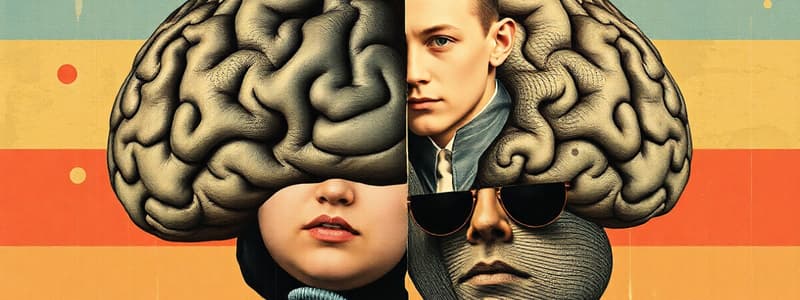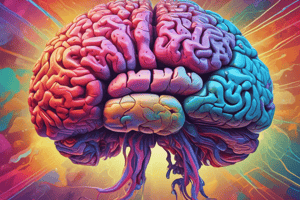Podcast
Questions and Answers
What behavior is typical of a securely attached baby when separated from their mother?
What behavior is typical of a securely attached baby when separated from their mother?
- Shows no distress when the mother leaves.
- Displays ambivalence in the mother's absence.
- Shows distress when the mother leaves but is easily comforted upon her return. (correct)
- Experiences extreme distress and remains upset.
Which attachment style is characterized by extreme distress during separation and ambivalence upon reunion?
Which attachment style is characterized by extreme distress during separation and ambivalence upon reunion?
- Secure attachment
- Dismissive attachment
- Anxious attachment (correct)
- Avoidant attachment
Which experiment observed the attachment behavior of infants when separated from their mothers?
Which experiment observed the attachment behavior of infants when separated from their mothers?
- Romanian Orphanage study
- Genie's language development study
- Ainsworth's Strange Situation experiment (correct)
- Harlow's monkey experiment
What was a key finding of Harlow's monkey experiment regarding attachment?
What was a key finding of Harlow's monkey experiment regarding attachment?
What term describes the times during development when specific skills are most easily learned?
What term describes the times during development when specific skills are most easily learned?
What does the Romanian Orphanage study illustrate about child development?
What does the Romanian Orphanage study illustrate about child development?
In what way did Genie's case contribute to our understanding of language development?
In what way did Genie's case contribute to our understanding of language development?
Which of the following is not characteristic of borderline personality disorder?
Which of the following is not characteristic of borderline personality disorder?
What is the primary function of Broca's area?
What is the primary function of Broca's area?
Which lobe of the brain is primarily involved in processing auditory information?
Which lobe of the brain is primarily involved in processing auditory information?
What characterizes Broca's aphasia?
What characterizes Broca's aphasia?
In the case of Phineas Gage, which area of the brain was damaged, affecting his personality?
In the case of Phineas Gage, which area of the brain was damaged, affecting his personality?
Which part of a neuron is responsible for insulating the axon and speeding up signal transmission?
Which part of a neuron is responsible for insulating the axon and speeding up signal transmission?
Which p-value indicates a significant result in a scientific study?
Which p-value indicates a significant result in a scientific study?
What is the primary role of the dendrites in a neuron?
What is the primary role of the dendrites in a neuron?
What occurs in classical conditioning?
What occurs in classical conditioning?
Which of the following describes the concept of 'Trust vs. Mistrust' in Erikson's stages of psychosocial development?
Which of the following describes the concept of 'Trust vs. Mistrust' in Erikson's stages of psychosocial development?
What characterizes the 'Autonomy vs. Shame' stage in Erikson's psychosocial development?
What characterizes the 'Autonomy vs. Shame' stage in Erikson's psychosocial development?
During which stage of Piaget's cognitive development do children begin to think symbolically and engage in imaginative play?
During which stage of Piaget's cognitive development do children begin to think symbolically and engage in imaginative play?
What is a defining feature of the 'Concrete Operational Stage' in Piaget's theory of cognitive development?
What is a defining feature of the 'Concrete Operational Stage' in Piaget's theory of cognitive development?
What are common symptoms of anxiety disorders as categorized in the DSM?
What are common symptoms of anxiety disorders as categorized in the DSM?
What differentiates obsessions from compulsions in Obsessive-Compulsive Disorder (OCD)?
What differentiates obsessions from compulsions in Obsessive-Compulsive Disorder (OCD)?
Which of the following is an example of a key symptom of Major Depressive Disorder?
Which of the following is an example of a key symptom of Major Depressive Disorder?
Which of the following is NOT a stage in Erikson's psychosocial development?
Which of the following is NOT a stage in Erikson's psychosocial development?
Flashcards
Bizarre Delusions
Bizarre Delusions
Implausible beliefs, impossible to occur in the real world
Depersonalization
Depersonalization
Feeling detached from one's own body
Derealization
Derealization
Feeling detached from surroundings
Dissociative Identity Disorder (DID)
Dissociative Identity Disorder (DID)
Signup and view all the flashcards
Bipolar II Disorder
Bipolar II Disorder
Signup and view all the flashcards
Major Depressive Disorder
Major Depressive Disorder
Signup and view all the flashcards
Secure Attachment (baby)
Secure Attachment (baby)
Signup and view all the flashcards
Critical Periods
Critical Periods
Signup and view all the flashcards
Neutral Stimulus (NS)
Neutral Stimulus (NS)
Signup and view all the flashcards
Sensorimotor Stage
Sensorimotor Stage
Signup and view all the flashcards
DSM-5
DSM-5
Signup and view all the flashcards
Major Depressive Disorder
Major Depressive Disorder
Signup and view all the flashcards
Obsessions
Obsessions
Signup and view all the flashcards
Compulsions
Compulsions
Signup and view all the flashcards
Hallucinations
Hallucinations
Signup and view all the flashcards
Delusions
Delusions
Signup and view all the flashcards
Broca's Area
Broca's Area
Signup and view all the flashcards
Wernicke's Area
Wernicke's Area
Signup and view all the flashcards
Frontal Lobe
Frontal Lobe
Signup and view all the flashcards
P-value (0.05)
P-value (0.05)
Signup and view all the flashcards
Classical Conditioning
Classical Conditioning
Signup and view all the flashcards
Neuron
Neuron
Signup and view all the flashcards
Axon
Axon
Signup and view all the flashcards
Myelin Sheath
Myelin Sheath
Signup and view all the flashcards
Study Notes
Brain Lobes and Areas
- The brain is divided into four lobes: frontal, parietal, occipital, and temporal.
- Broca's area, located in the left frontal lobe, is responsible for speech production.
- Wernicke's area, situated in the left temporal lobe, is crucial for language comprehension.
Functions of Brain Lobes
- Frontal lobe: Involved in decision-making, problem-solving, control of behaviors, emotions, and language.
- Parietal lobe: Processes sensory information like touch, temperature, and pain.
- Occipital lobe: Responsible for visual processing.
- Temporal lobe: Processes auditory information and is involved in memory and emotions.
Aphasia
- Broca's aphasia: Difficulty producing speech, but patients generally understand language.
- Wernicke's aphasia: Fluent speech production, but often lacking meaning and comprehension.
Phineas Gage
- Phineas Gage suffered a traumatic brain injury to his frontal lobe.
- The case highlighted the role of the frontal lobe in personality, decision-making, and social behaviour.
Neuron Structure
- Parts of a neuron: soma (cell body), dendrites, axon, myelin sheath, and axon terminals.
Functions of Neuron Components
- Soma: Processes information and contains the nucleus.
- Dendrites: Receive signals from other neurons.
- Axon: Carries signals away from the soma.
- Myelin sheath: Insulates the axon and speeds up signal transmission.
- Axon terminals: Release neurotransmitters for communication with other neurons.
Significance of P-Values
- P-values indicate the statistical significance of results.
- A p-value of 0.01 or less is generally considered significant.
- A p-value above 0.05 typically indicates results are not statistically significant.
Classical Conditioning
- A learning process where a neutral stimulus is associated with an unconditioned stimulus to produce a conditioned response.
- Key terms: Neutral stimulus, Unconditioned Response, Unconditioned Stimulus, Conditioned Stimulus, Conditioned Response.
Piaget's Stages of Cognitive Development
- Sensorimotor (0-2 years): Learning through sensory experiences.
- Preoperational (2-7 years): Symbolic thinking, egocentrism, and imagination.
- Concrete Operational (7-11 years): Logical thinking about concrete events.
- Formal Operational (12+ years): Abstract and moral reasoning.
Erikson's Stages of Psychosocial Development
- A theory describing eight stages of development across the lifespan, each with a unique psychosocial conflict.
DSM
- Diagnostic and Statistical Manual of Mental Disorders, used for diagnosis of mental disorders.
Anxiety Disorders
- The DSM outlines various anxiety disorders (Generalized Anxiety Disorder, Panic Disorder, Social Anxiety Disorder, specific phobias).
- Key symptoms commonly include excessive worry, avoidance, and physical symptoms.
Depressive Disorders
- The DSM categorizes depressive disorders (Major Depressive Disorder, Persistent Depressive Disorder, Disruptive Mood Dysregulation Disorder).
- Key symptoms comprise depressed mood, diminished interest, and potentially suicidal thoughts.
DSM-5 New Additions
- Disruptive Mood Dysregulation Disorder (DMDD): temper outbursts in children
- Premenstrual Dysphoric Disorder (PMDD): severe mood disturbances linked to the menstrual cycle
Obsessive-Compulsive Disorder (OCD)
- Obsessions: Recurrent unwanted thoughts
- Compulsions: Repetitive behaviours to reduce distress from obsessions.
Schizophrenia
- Hallucinations: Sensory experiences without external stimuli (e.g., hearing voices).
- Delusions: False beliefs despite evidence to the contrary.
Dissociative Disorders
- Dissociative Identity Disorder (DID): Presence of multiple distinct personalities.
- Dissociative disorders typically arise from trauma or extreme stress.
Critical and Sensitive Periods
- Periods during development that are optimal for certain developmental skills to be learnt.
Attachment
- Ainsworth's Strange Situation experiment: Observed attachment styles (secure, anxious, avoidant) of babies separated from their mothers.
- Harlow's monkey experiment: Demonstrated that comfort is more important than feeding for attachment.
John Bowlby's Attachment Theory
- Attachment theory suggests early relationships with caregivers establish later emotional and social development.
Language Development
- Genie's case: Limited language development due to lack of early exposure.
Classical Conditioning Example
- Jeremy: Loud noise (UCS) is associated with PlayStation (CS) causing fear (CR).
Studying That Suits You
Use AI to generate personalized quizzes and flashcards to suit your learning preferences.




